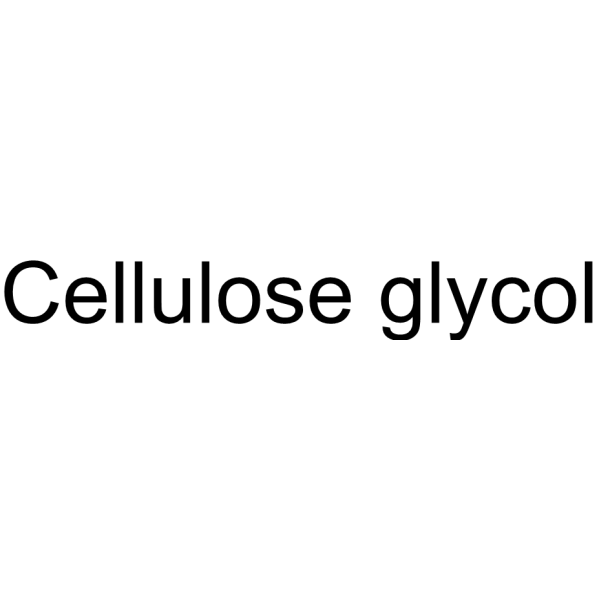
| 规格 | 价格 | 库存 | 数量 |
|---|---|---|---|
| 1g |
|
||
| Other Sizes |
|
| 体外研究 (In Vitro) |
所得到的纳米杂化物被证明适合在水溶液中应用,因为羟乙基纤维素被用来稳定生理液体中的氧化石墨烯。羟乙基纤维素可以有效地稳定溶液中的氧化石墨烯,并且稳定机制似乎取决于羟乙基纤维素的存在量。该混合物的羟乙基纤维素含量对于最终用途至关重要,可以作为叶酸的主要药物载体或控制药物释放的载体[1]。在冻融过程中,羟乙基纤维素表现出显着的抗乳糖二磷酸 (LDH) 冷冻保护作用和显着的冻干保护作用。冷冻对羟乙基纤维素的稳定性影响不大。吐温 80 是一种表面活性剂,可在冷冻干燥前添加到配方中,以显着延长羟乙基纤维素冻干物的较长重构时间 [2]。
|
|---|---|
| 参考文献 |
|
| 其他信息 |
Hydroxyethyl cellulose is a polysaccharide derivative with gel thickening, emulsifying, bubble-forming, water-retaining and stabilizing properties. It is used as a key ingredient in many household cleaning products, lubricants and cosmetics due to its non-ionic and water-soluble nature. It is often used as an ingredient in ophthalmic pharmaceutical preparations such as artificial tear solutions and adjunct agent in topical drug formulations to facilitate the delivery of drugs with hydrophobic character.
Drug Indication For alleviating surface irritation in topical ocular administrations, such as artificial tear solutions. Hydroxyethyl cellulose is also found in topical formulations to aid in more efficient drug diffusion across the membranes. Mechanism of Action Interacts with the solid surface through hydrogen bonding to thicken and prolong the formation time of a water-retaining film. Hydroxyethyl cellulose acts as a drug carrier or microsphere to entrap other drug molecules and form a viscous gel-like dispersion, enabling drug diffusion across biological membranes. Pharmacodynamics Hydroxyethyl cellulose acts as a demulcent by relieving inflammation or irritation and dryness of eyes. It acts as one of the key ingredient and viscosity-enhancing agent to prolong corneal contact time and increase intraocular drug levels. |
| 分子式 |
C29H52O21
|
|---|---|
| 分子量 |
736.7106
|
| 精确质量 |
154.012
|
| CAS号 |
9004-62-0
|
| 相关CAS号 |
Cellulose;9004-34-6;CM Cellulose CM-32;9000-11-7
|
| PubChem CID |
24846132
|
| 外观&性状 |
White to off-white solid powder
|
| 密度 |
0.75 g/mL at 25ºC(lit.)
|
| 熔点 |
288-290ºC (dec.)
|
| LogP |
0.352
|
| tPSA |
91.06
|
| 氢键供体(HBD)数目 |
11
|
| 氢键受体(HBA)数目 |
21
|
| 可旋转键数目(RBC) |
15
|
| 重原子数目 |
50
|
| 分子复杂度/Complexity |
999
|
| 定义原子立体中心数目 |
0
|
| InChi Key |
CWSZBVAUYPTXTG-UHFFFAOYSA-N
|
| InChi Code |
InChI=1S/C29H52O21/c1-10-15(34)16(35)24(13(8-33)45-10)49-28-20(39)18(37)25(50-29-26(43-5-4-30)21(40)23(42-3)12(7-32)47-29)14(48-28)9-44-27-19(38)17(36)22(41-2)11(6-31)46-27/h10-40H,4-9H2,1-3H3
|
| 化学名 |
5-[6-[[3,4-dihydroxy-6-(hydroxymethyl)-5-methoxyoxan-2-yl]oxymethyl]-3,4-dihydroxy-5-[4-hydroxy-3-(2-hydroxyethoxy)-6-(hydroxymethyl)-5-methoxyoxan-2-yl]oxyoxan-2-yl]oxy-6-(hydroxymethyl)-2-methyloxane-3,4-diol
|
| HS Tariff Code |
2934.99.9001
|
| 存储方式 |
Powder -20°C 3 years 4°C 2 years In solvent -80°C 6 months -20°C 1 month |
| 运输条件 |
Room temperature (This product is stable at ambient temperature for a few days during ordinary shipping and time spent in Customs)
|
| 溶解度 (体外实验) |
H2O : ~9.09 mg/mL
DMSO : ~1 mg/mL |
|---|---|
| 溶解度 (体内实验) |
配方 1 中的溶解度: 50 mg/mL (Infinity mM) in PBS (这些助溶剂从左到右依次添加,逐一添加), 澄清溶液; 超声助溶。
请根据您的实验动物和给药方式选择适当的溶解配方/方案: 1、请先配制澄清的储备液(如:用DMSO配置50 或 100 mg/mL母液(储备液)); 2、取适量母液,按从左到右的顺序依次添加助溶剂,澄清后再加入下一助溶剂。以 下列配方为例说明 (注意此配方只用于说明,并不一定代表此产品 的实际溶解配方): 10% DMSO → 40% PEG300 → 5% Tween-80 → 45% ddH2O (或 saline); 假设最终工作液的体积为 1 mL, 浓度为5 mg/mL: 取 100 μL 50 mg/mL 的澄清 DMSO 储备液加到 400 μL PEG300 中,混合均匀/澄清;向上述体系中加入50 μL Tween-80,混合均匀/澄清;然后继续加入450 μL ddH2O (或 saline)定容至 1 mL; 3、溶剂前显示的百分比是指该溶剂在最终溶液/工作液中的体积所占比例; 4、 如产品在配制过程中出现沉淀/析出,可通过加热(≤50℃)或超声的方式助溶; 5、为保证最佳实验结果,工作液请现配现用! 6、如不确定怎么将母液配置成体内动物实验的工作液,请查看说明书或联系我们; 7、 以上所有助溶剂都可在 Invivochem.cn网站购买。 |
| 制备储备液 | 1 mg | 5 mg | 10 mg | |
| 1 mM | 1.3574 mL | 6.7869 mL | 13.5739 mL | |
| 5 mM | 0.2715 mL | 1.3574 mL | 2.7148 mL | |
| 10 mM | 0.1357 mL | 0.6787 mL | 1.3574 mL |
1、根据实验需要选择合适的溶剂配制储备液 (母液):对于大多数产品,InvivoChem推荐用DMSO配置母液 (比如:5、10、20mM或者10、20、50 mg/mL浓度),个别水溶性高的产品可直接溶于水。产品在DMSO 、水或其他溶剂中的具体溶解度详见上”溶解度 (体外)”部分;
2、如果您找不到您想要的溶解度信息,或者很难将产品溶解在溶液中,请联系我们;
3、建议使用下列计算器进行相关计算(摩尔浓度计算器、稀释计算器、分子量计算器、重组计算器等);
4、母液配好之后,将其分装到常规用量,并储存在-20°C或-80°C,尽量减少反复冻融循环。
计算结果:
工作液浓度: mg/mL;
DMSO母液配制方法: mg 药物溶于 μL DMSO溶液(母液浓度 mg/mL)。如该浓度超过该批次药物DMSO溶解度,请首先与我们联系。
体内配方配制方法:取 μL DMSO母液,加入 μL PEG300,混匀澄清后加入μL Tween 80,混匀澄清后加入 μL ddH2O,混匀澄清。
(1) 请确保溶液澄清之后,再加入下一种溶剂 (助溶剂) 。可利用涡旋、超声或水浴加热等方法助溶;
(2) 一定要按顺序加入溶剂 (助溶剂) 。